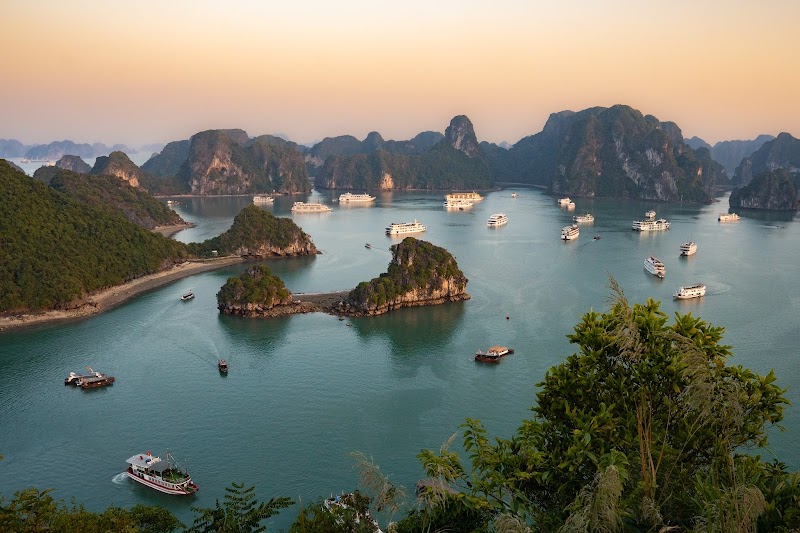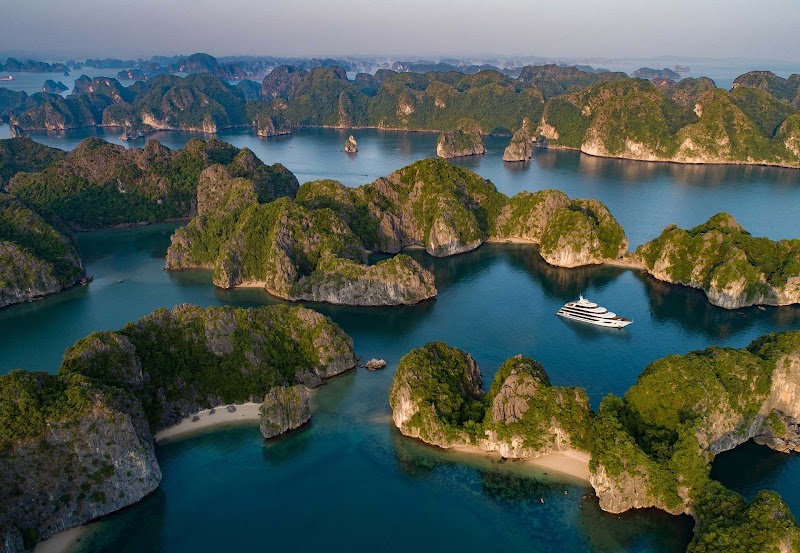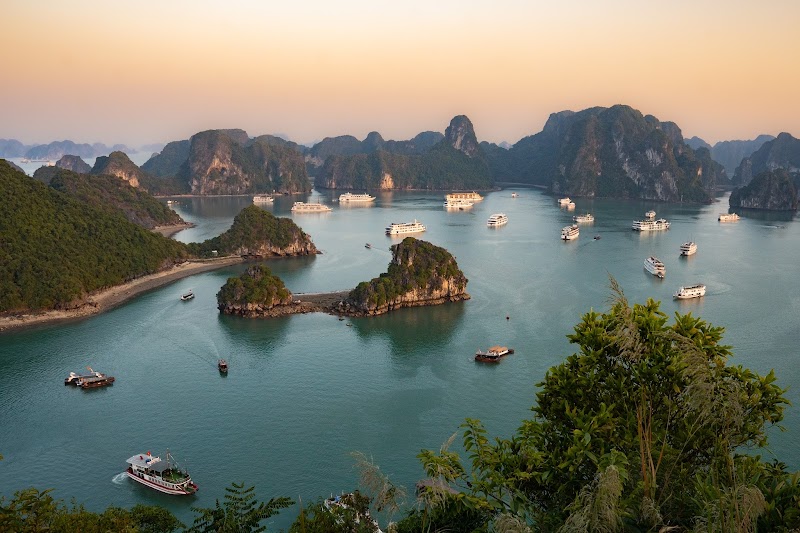Are you aware that Ha Long Bay, a UNESCO World Heritage site in Vietnam, is home to over 1,600 limestone islands and islets? Each of these natural wonders is like a masterpiece of nature's art, filled with awe-inspiring caves, secluded beaches, and vibrant eco-systems. As you set sail on your adventure, allow the captivating Sung Sot Cave, the serene Bai Tu Long Bay, and the majestic Titop Island to spark your imagination. A world of wonders awaits you in Ha Long Bay.
As you gear up to explore this breathtaking destination, the Ha Long Bay tourist map will be your trusted guide, leading your exploration and unveiling the bay's hidden treasures. This tool is more than just a map; it's your personal path through the labyrinth of natural beauty, assisting you in tailoring your adventure and ensuring you make the most of your journey through this mesmerizing landscape.
Booking.comDiscover the Hidden Treasures of Ha Long Bay, Vietnam
While the mesmerizing beauty of Ha Long Bay's limestone islands and the vibrant ecosystem of the UNESCO World Heritage Site are well-documented, there are still uncharted treasures waiting for you. Dive deeper into the heart of Ha Long Bay and uncover the richness of its cultural history, its unparalleled natural offerings, and the magical experiences that await every traveler.
Immerse Yourself in the Local Culture at Cua Van Floating Village
Experience the authentic Vietnamese way of life at Cua Van Floating Village, the largest and most picturesque of the four remaining floating villages in Ha Long Bay. Here, you'll witness the harmonious co-existence of man, sea, and limestone mountains. It's not just a visit; it's an opportunity to understand how the locals have adapted to life on water, preserving their cultural traditions amid the ever-changing tides. Consult the tourist map of Vietnam to locate this charming village.
Spotlight on Lesser Known Islands: Quan Lan and Cat Ba
Stray from the beaten path and head towards Quan Lan and Cat Ba, two of Ha Long Bay's less crowded but equally captivating islands. Quan Lan, with its untouched beaches and peaceful ambiance, offers a tranquil retreat from the bustling tourist spots. On the other hand, Cat Ba, the largest island in the bay, is a haven of diverse ecosystems—a home to the endangered Cat Ba langur and a host of other unique wildlife species. You can plan your visit to this paradise using the Cat Ba travel guide. These two islands offer a refreshing perspective on Ha Long Bay's beauty, showcasing its diverse natural richness beyond the popular limestone karsts.
Revitalize Your Senses at Lan Ha Bay
Just south of Ha Long Bay, you'll find Lan Ha Bay, a lesser-known but equally captivating destination. Lan Ha Bay, a natural wonderland of over 400 islands and islets, offers a stunning panorama that rivals its more famous neighbor. Lan Ha Bay stands out for its pristine condition, with crystal clear waters ideal for various water activities like kayaking and swimming. The bay also harbors a rich marine life, adding another dimension of intrigue to your exploration. Visit Ninh Binh tourist map for more off-the-beaten-path destinations in Vietnam.
Indulge in the Culinary Delights of Ha Long Bay
Your Ha Long Bay experience isn't complete without tasting its rich culinary heritage. The Bay is renowned for its seafood, particularly the succulent Ha Long squid, making a seafood feast an absolute must-try. Local specialties such as 'cha muc' (squid sausage) and 'sam' (horseshoe crab) offer a unique gastronomic experience, bringing you closer to the local culture and traditions.
Remember, Ha Long Bay isn't just about its breathtaking scenery but also about the moving stories, the rich culture, and the unique experiences that make every visit truly unforgettable.

Practical Information for Visiting Ha Long Bay
Transportation and Mobility
Ha Long Bay, a UNESCO World Heritage site, is situated in northeastern Vietnam and is accessible by various modes of transport. The most common way to reach Ha Long Bay is by road from Hanoi, with the journey taking approximately three to four hours. Buses are available from My Dinh bus station in Hanoi to Bai Chay bus station in Ha Long City. If you prefer a more comfortable journey, you can opt for a private taxi or a minivan.
Once you reach Ha Long Bay, the primary mode of transportation is by boat. You can choose from a range of options, including traditional junk boats, luxury cruises, or private speedboats, depending on your budget and preference.
Schedules and Prices
It's important to note that the operating hours of most boat tours in Ha Long Bay are from 6:00 AM to 6:00 PM. The prices for these tours vary widely, depending on the type of boat and the itinerary. A standard day tour on a junk boat can cost around VND 350,000 ($15) per person, while overnight cruises can range from VND 1,500,000 ($65) to VND 7,000,000 ($300) per person.
Safety Tips
While Ha Long Bay is generally safe for tourists, there are certain precautions that you should take. Always wear a life jacket when you're on a boat, regardless of the weather conditions. Make sure to check the weather forecast before setting off on a boat trip, as sudden storms can occur.
Furthermore, it's advisable to book boat tours through a reputable company to ensure safety standards are met. Avoid vendors selling tours on the street as their safety standards might be questionable.
Practical Recommendations
The best time to visit Ha Long Bay depends on your preferences. If you want to avoid the crowd, consider visiting in the off-peak season (May to September). However, be aware that this period coincides with the rainy season, and some tours might be canceled due to bad weather.
Make sure to bring sun protection, as the sun can be quite strong, especially during the summer months. Also, packing a light jacket is a good idea as it can get chilly on the boat in the evenings or during the cooler months.

Frequently Asked Questions
1. What are some unique experiences to enjoy in Ha Long Bay at night?
Ha Long Bay is a destination that doesn't sleep when the sun sets. Overnight cruises offer a unique chance to see the bay from a different perspective, with the limestone karsts beautifully illuminated under the moonlight. You might also get to participate in squid fishing, a popular local activity. On land, the bustling night market in Ha Long city provides a vibrant shopping experience, featuring local crafts, fresh seafood and delicious street food.
2. I'm travelling with kids. What are some family-friendly activities in Ha Long Bay?
Ha Long Bay is a family-friendly destination offering a range of activities suitable for all ages. The Sun World Ha Long Complex is a popular choice, boasting an amusement park, a water park, and a cable car with stunning views over the bay. Tuan Chau, a nearby island, offers animal shows and outdoor activities that will keep the young ones entertained. Remember that many boat tours and caves are also suitable for children, making Ha Long Bay a versatile family destination.
3. Are there any eco-friendly travel options in Ha Long Bay?
Yes, Ha Long Bay is increasingly focusing on sustainable tourism. Several cruise operators now offer eco-friendly options, using sustainable practices such as reduced fuel consumption, onboard recycling, and avoiding plastic waste. There are also kayak tours that allow you to explore the bay without causing any pollution. When choosing your activities, look for options that respect the local environment and contribute to its preservation.
4. What local festivals can I experience when visiting Ha Long Bay?
Experiencing a local festival is a wonderful way to immerse in the vibrant cultural tapestry of Ha Long Bay. The most significant is the Carnaval Ha Long, usually held in April, which features colorful parades, performances, and fireworks. Additionally, the Yen Tu festival, a major Buddhist event taking place in February and March, draws pilgrims from all over Vietnam to the Yen Tu Mountain.
5. Any recommendations for off-the-beaten-path experiences in Ha Long Bay?
For those looking for less touristy experiences, a visit to the local pearl farms offers a fascinating insight into the intricate process of pearl cultivation. Another option is to explore the lesser-known Cong Dam area, a secluded, pristine part of the bay with stunning karst formations and clear waters, perfect for swimming and kayaking. Remember that respectful and responsible tourism helps preserve these untouched areas for future generations.
6. Can I volunteer or contribute to the local community during my visit?
Yes, there are several ways to give back to the local community. Organizations such as the Green Ha Long offer opportunities to participate in beach clean-ups and other conservation efforts. You might also consider purchasing handicrafts directly from local artisans or using community-based tourism services. These actions not only enrich your travel experience but also support the local economy and help protect the natural beauty of Ha Long Bay.

